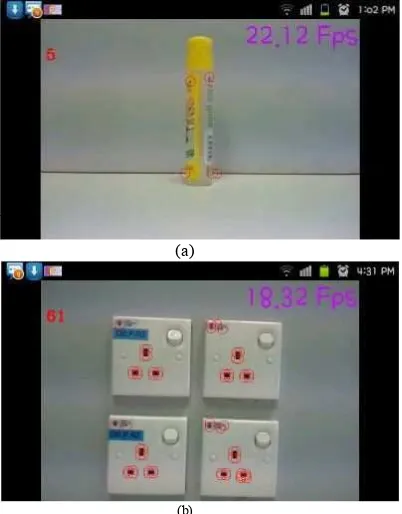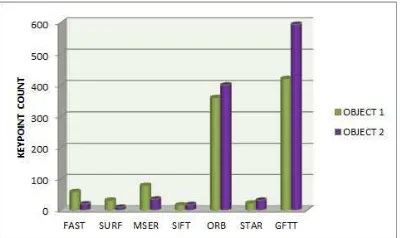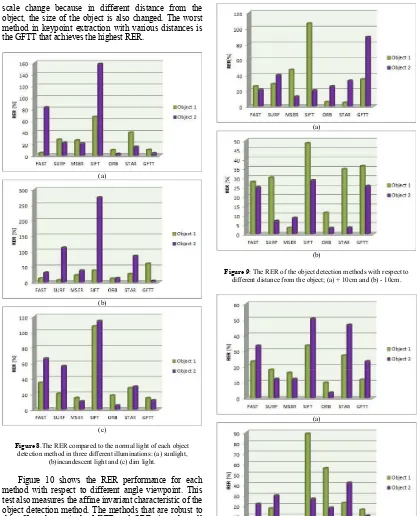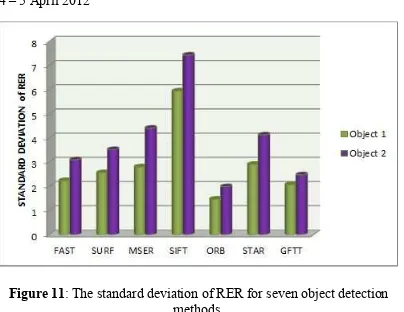ANALYSIS OF REAL-TIME OBJECT DETECTION METHODS FOR
ANDROID SMARTPHONE
NurulAtiqahbinti Ismail
1,*,KhairulMuzzammil bin Saipullah2,Ammar Anuar
3, Nuraishah Sarimin
4and
Yewguan Soo
51,2,3,4Department of Electronic and Computer Engineering, Faculty of Electronic and Computer
Engineering,UniversitiTeknikal Malaysia Melaka (UTeM) Hang Tuah Jaya 76100 Durian Tunggal Melaka Malaysia. Email:[email protected],[email protected], [email protected],
[email protected], [email protected]
Abstract—This paper presents the analysis of real-time object detection method for embedded system, especially the Android smartphone. As we all know, object detection algorithm is a complicated algorithm that consumes high performance hardware to execute the algorithm in real time. However due to the development of embedded
hardware and object detection algorithm, current
embedded device may be able to execute the object detection algorithm in real-time. In this study, we analyze the best object detection algorithm with respect to efficiency, quality and robustness of the object detection. A lot of object detection algorithms have been compared such as Scale Invariant Feature Transform (SIFT), Speeded-Up Feature
Transform (SuRF), Center Surrounded Extrema
(CenSurE), Good Features To Track (GFTT), Maximally-Stable Extremal Region Extractor (MSER), Oriented Binary Robust Independent Elementary Features (ORB), and Features from Accelerated Segment Test (FAST) on the GalaxyS Android smartphone. The results show that FAST algorithm has the best combination of speed and object detection performance.
Keywords Android; computer vision; embedded hardware;
mobile application; OpenCV.
I. INTRODUCTION
As we all know, an embedded device does not utilize high performance hardware since most of the embedded devices are powered by batteries. So, most of the embedded devices are unable to execute complicated computation such as object detection algorithm that consumes a lot of steps and loops. However, lately, the smartphone wave has changed the composition of hardware for embedded device. The processor becomes wider with more cores and becomes faster even with smaller power consumption.
Smartphone – the combination between the personal digital assistant (PDA) and mobile phone has totally changed the myth about mobile phone which is only mobile phone company can develop its application. Since the launch of the Android operating system (OS) [1] in 2007, mobile development has been high in demand [2]. Android is developed by Google and is based upon the Linux kernel and GNU software.
Since the development of Scale Invariant Feature Transform (SIFT) [3],the world have shift the focus from matching filter based object detection to keypoint matching based object detection method. Due to the
robust performance of SIFT, the object detection algorithm is more focusing to invariant keypoint matching based object detection methods. Since then, there are a lot of similar concept object detection algorithms are born such as the Speeded-Up Feature
Transform (SuRF), Center Surrounded
Extrema(CenSurE), Good Features To Track (GFTT), Maximally-Stable Extremal Region Extractor (MSER), Oriented Binary Robust Independent Elementary Features (ORB), and Features from Accelerated Segment Test (FAST).[4-9].
In this paper, we analyze the best object detection algorithm with respect to efficiency, quality and robustness of the object detection algorithm. Some of the tests that are conducted are the speed per frametest,features count test,repeatability test, and error rate test in various illuminations and view angles. All of the experiments are conducted on Samsung’s GalaxyS smartphone that is powered by 1 GHz ARM Cortex-A8 processor running with Android 2.3 Gingerbread OS.
This document is organized as follows: in section II, related works of object detection methods are discussed. Section III illustrates the methodology implemented and section IV shows the results obtained and the analysis applications are widely use especially in human-computer interaction, visual surveillance, robot navigation and many more. Object detection is use to detect the main point of object in an image. Generally, object detection is divided into three stages. In the first stage, representation of feature requiring for object recognition is examined based on local or global image information. Local image is for detecting object in certain part and global image is use to detect object in general image. Second stage is classification of image based on extracted features. The last stage is recognition of the new image based on learning machine which is performed with training images.
isinvariant to image scale, noise and illumination. SIFT algorithm can be divide into four feature informationstage which are scale-space extrema detection, keypoint
localization, orientation assignment and
keypointdescriptors. The scale-space extrema detection is used to detect the interest point and also known as keypoint. Then the image will convolve with Gaussian filter with different scales of image. Keypoint is taken from the maxima or minima of Difference of Gaussian (DoG). The second stage is keypoint localization.Among the keypoint candidates, the selection is made by using the comparison between each pixel. In orientation invariant, each pixel is assign on local image gradient directions. The last stage is keypoint descriptor which is used to find the location of the objects with different orientation and scale. The keypoint descriptor is invariant to the image location, scale and rotation. The SIFT utilizes Harris corner detector and have a good performance but not effective due to real-time of object recognition because expansion computationof the feature detection and keypoint descriptor [3].
Figure 1.The process of extract DOG values.
For the faster feature matching, Speed up Robust Feature (SURF) algorithm has a similar performance with SIFT butis much faster than SIFT. SURF builds image pyramid and does filtering for each layer with Gaussian of increasing sigma by taking the difference between the layers. Since image pyramid are used in the multi-resolution image, the Gaussian of different scale is made using a constant filter size.SIFT looks for extrema in Difference of Gaussian filtered versions of an image. This computation is done for many image sizes, or octaves, and with a variety of different strength blurs, or scales. Simplified scale-space extreme detection in SURF algorithm speed up feature extraction speed, therefore it
is being faster than SIFT. SURF algorithmis also has difficulties to produce real-time object recognition [3].
FAST corner detector is based on the corner information. It is widely used to track object in different corner. FAST corner detector is unlike SIFT and SURF where the FAST detector does not utilize the descriptor. Even though the FAST corner is 10 times faster than those of SIFT and SURF, it is able to get accurate interest point information. FAST corner detector is possible to recognize simple markers using template matching because affine transformations (changes in scale, rotation and position) are limited in such a case. FAST detector is less applicable for object detection and recognition because it reduces the time for feature extraction [4].
Good Features to Track (GFTT) is a feature detector that is based on the Harris corner detector. The main improvement is that it findscorners that are good to track under affine image transformations.Maximally Stable Extremal Regions (MSER) is used as a method of blob detection in images. This method is use to find correspondence between two image with different viewpoint. MSER is appliedwith binary image. All pixels inside MSER have ‘extremal’ where it refers to the higher or lower intensity than all the pixels on its outer boundary. Meanwhile, MSER regions are ‘maximal stable’ in the threshold selection process [5][9].
Oriented FAST and rotated BRIEF (ORB) is very fast binary descriptor based on BRIEF descriptor. ORB is combination of FAST detector and BRIEF descriptor. BRIEF is a feature descriptor that uses simple binary tests in a smoothed image patch. It is similar to SIFT regarding to invariant to lighting, blur and distortion but the weakness is very sensitive to the rotation [6][10].
Center Surrounded Extrema (CenSurE)uses polygon, hexagon and octagonfilters as more computable alterative to circle filter. First,CenSurEcomputes all the locationand scales to find the local extrema in a neighborhood by simplified center-surround filter. ThenHarris detector is
use to eliminate the entire weak
corner.CenSurEappliessimple approximations where it uses bi-level center surround filter by multiply the image value to 1 and -2. Figure 2 shows the bi-level Laplacian of Gaussian and other examples of approximations that are use to conjugate with integral images [7].
Figure 2. Center-Surround bi-level filters approximating the Laplacian. III. METHODOLOGY
(SDK), OpenCV and JAVA SDK. The compiled object is thenuploaded tothe Samsung GalaxyS. If there are no errorsoccurred, the experiment is conducted by setting the orientation of the Galaxy S and illumination of experiment area. Then we start to measure and collect the result regarding of speed, number of feature, repeatability and robustness. After all the data had been collected, then the result is analyzed and compared with the theory.
Figure 3.The flow chart of the experiment.
In this experiment there are two objects are used.The first object is power socket and the second object is glue. All the experiments are executed on a computer with an Intel Core 2 Duo 2.66GHz and 4GB main memory and object detection system was built Samsung’s GalaxyS Smartphone that is powered by 1 GHz ARM Cortex-A8 processor running with Android 2.3 Gingerbread OS. There are seven method had been compared. The methods are SIFT, SURF, MSER, FAST, CenSurE, ORB and GFTT.
IV. EXPERIMENTAL STUDIES A. Experiment measures
There are a lot of experiments are conducted in order to evaluate the performances of each object detection
methods. The details of those experiment measures are as follows:
1. Speed
To measure the speed per frame (fps) test, the processing time of each object detection method for one frame is recorded. From this information, the number of frame that can be processed in one second can be calculated.Each object detection method is executed on the video captured by the camera. 10 continuous frames are selected and the average processing speed for one frame is used to measure the fpsonthe two different objects. The higher value of the fps is the higher speed of the method to process the frame.
(a)
(b)
Figure 4. Object is used in the experiment. (a) Glue image, (b) Power socket.
2. Number of keypoint
In this experiment, the number of keypoint for each object detection methods is recorded. The motive of this experiment is to measure the number of maximum keypoint that is extracted from each object detection method. The average keypointcount per frame of 10 continuous frames is recorded. Note that the large number of keypoint is a drawback in object detection since more points need to be matched compared to smaller number of keypoint.
3. Repeatability
In this case, the repeatability performance is measured by observing the consistency of the repeatability error rate (RER). The locations of keypoints for 20 continuous frames are recorded. From the 20 frames, we located the keypoints that always appear in
no
each frame. The repeatability error rate is calculated by dividing the number of non-overlapping keypoint with the number ofkeypoint that always appear in each frame that we called as the number of reference keypoints. The keypoint is considered is non-overlapping is the distance of the keypoint is larger than 10 pixels from the reference keypoint.The formula to calculate repeatability error rate is as follows:
(1)
To measure the consistency of the RER, the standard deviation is calculated. A high RER standard deviation means that the object detection keypoint is inconsistent.
Figure 5. From the top left to top right arethe image with angle orientation for -30° and +30° and from the bottom right to bottom left
are the images with+10 cm and -10 cm distance. 4. Robustness
In order to measure the robustness of each algorithm, we evaluate the performance in two different cases. The first case is regarding the orientation of the smartphone and the second is the illumination. For the orientation, the smartphone is moved 10cm forward (+10cm) and backward (-10cm) and 30 º angles to left (+30°) and right (-30°). For the illumination four types of lighting are used which arethe fluorescent light (normal), sunlight, dim light (without the room light) and incandescent light. The samples of the object in various orientation and illumination are shown in Figure 5.
[8]The robustness performance can be measure by observing the RER from the equation (1). However instead of using the keypoint that appear on each frame as the reference point, we use the keypoint in the normal location and illumination as the reference point so that we can observe repeatability difference between the keypoint in normal illumination, and orientation and the keypoints in different illuminations, and orientations.
V. EXPERIMENTAL RESULT
Figure6 shows the performance of speed per frame test for seven object detection methods. As shown in the graph, the FAST algorithm achieves the highest fps value while the SIFT algorithm achieves the lower fps than the other algorithms. We also can see that FAST is 10 times
faster than SIFT and SURF. The minimum fps rate for real-time video is 15 fps. This shows that FAST achieves the optimum real-time video performance while executing the object detection algorithm.
[9]
Figure 6.Frame Processing Rate for the seven object detection methods. Figure7 showed the performance of seven object detection methodsregarding the average number of future per framein ten seconds. GFTT and ORB extracted extremely high number of keypoints compared to other methods. This shows that GFTT and ORB is very sensitive to noise and corners in image. This high number of keypoint will also increase the matching process time since more keypoints need to be matched.
Figure 7.Future count for the seven objet detection methods. Figure 8 shows the performance of each algorithm in different type of illuminations.The RER is calculated by dividing the repeatability error in difference illuminations with the repeatability error in normal condition which is the fluorescence light. We can see that the SIFT method achieves high RER compared to other method in each different illuminations. This shows that SIFT is sensitive to illumination change. In the incandescent and dim light, the light source is minimal and this will causes new object to appear on the image such as the shadow. This situation will also produce a lot of noise in the image. Out of all, the ORB achieves the lowest RER compared to other methods. This shows that ORB is really insensitive to shadow and noise. FAST and GFTT also shows a good performance in different illumination with low RER.
scale change because in different distance from the object, the size of the object is also changed. The worst method in keypoint extraction with various distances is the GFTT that achieves the highest RER.
(a)
(b)
(c)
Figure 8.The RER compared to the normal light of each object detection method in three different illuminations: (a) sunlight,
(b)incandescent light and (c) dim light.
Figure 10 shows the RER performance for each method with respect to different angle viewpoint. This test also measures the affine invariant characteristic of the object detection method. The methods that are robust to this affine change is the MSER and ORB since they all achieves low RER compared to other methods.
[11]Figure 11 shows the standard deviation of RER for each method. The lowest RER standard deviation is achieves by ORB followed by GFTT and FAST. This shows that these three methods perform feature extraction consistently compared to other methods. The worst and inconsistent method is the SIFT.
(a)
(b)
Figure 9: The RER of the object detection methods with respect to different distance from the object; (a) + 10cm and (b) - 10cm.
(a)
(b)
Figure 11: The standard deviation of RER for seven object detection methods.
V. CONCLUSIONS AND FUTURE WORKS In this paper, we analyzed the object detection methods with respect to efficiency, quality and robustness of the object detection. The overall performances showed that the FAST algorithm have the best average performance with respect to speed, number of keypointand repeatability error. The most robust object detection method is the ORB that achieves the lowest RER even in different illumination and orientation. However ORB method consumes too much time in computing its algorithm and does not archives real-time video performance. Except FAST, allother algorithms consume too much time in the computation thus result in lagging on the video that reduce the video quality significantly. Only FAST achieves the real-time performance in the object detection in an embedded device.However the object detection performance of FAST is not significantly high compared to other object detection methods and also a little insensitive to orientation and illumination change. For the future work, we would like to modify the FAST algorithm to be more accurate in the feature detection while maintaining the processing speed. We also would like to perform a specific object detection task with new FAST algorithm such as face recognition, vehicle type classification, or road analysis for unmanned vehicle applications.
VI. ACKNOWLEDGEMENT
This paper is supported by UniversitiTeknikal Malaysia Melaka under PJP/2011/FKEKK(44B)/S00979 and PJP/2011/FKEKK (6B)/S00840.
VII. REFERENCES
[1] Industry leaders announce open platform for mobile devices, November 2007.
[2] K. Owen, An Executive Summary of Research in Android & Integrated Development Environments, April 2011.
[3] Paul Viola, Michael Jones, Robust Real-time Object Detection, Second International Workshop on Statistical and Computational Theories of Vision, July 2001.
[4] KanghunJeong, Hyeonjoon Moon, Object Detection using FAST Corner Detector based on Smartphone Platforms, Computers, Networks, Systems and Industrial Engineering (CNSI), May 2011. [5] Donoser, M.; Bischof, H. “Efficient Maximally Stable Extremal
Region (MSER) Tracking,” IEEE Computer Society Conference
on Computer Vision and Pattern Recognition, pp.553-560, June 2006.
[6] Ethan Rublee Vincent Rabaud Kurt Konolige Gary Bradski, ORB: an ef cient alternative to SIFT or SURF.
[7] Agrawal, M., K. Konolige, et al.“CenSurE: Center Surround Extremas for Realtime Feature Detection and Matching,”Computer Vision – ECCV 2008, Springer Berlin / Heidelberg.vol.5305, pp.102-115, 2008.
[8] David G. Lowe, “Object Recognition from Local Scale-Invariant Features,”The Proceedings of the Seventh IEEE International Conference on Computer Vision,pp. 1150-1157, 1999.
[9] Clemens Arth, Christian Leistner, Horst Bischof, “Robust Local Features and their Application in Self-Calibration and Object Recognition on Embedded Systems,”Computer Vision and Pattern Recognition,2007. IEEE Conference, June 2007.
[10] Calonder, M., V. Lepetit, et al. “BRIEF: Binary Robust Independent Elementary Features,” Computer Vision – ECCV 2010, Springer Berlin / Heidelberg. Vol. 6314, pp.778-792, 2010. [11] AmmarAnuar, KhairulMuzzammilSaipullah, NurulAtiqah Ismail,




